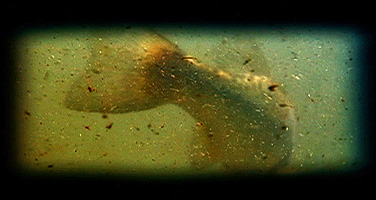News
‘Biological Regionalism’ examined

Alberto Rey, “Biological Regionalism, Ellicott Creek, Amherst, New York,” 2009, video still
An installation by Cuban artist and UB alumnus Alberto Rey, opening March 18 in the UB Art Gallery in the Center for the Arts, North Campus, will submerge observers into a hypnotic, aquatic environment.
The installation, titled “Alberto Rey: Biological Regionalism, Ellicott Creek, Amherst, New York,” will be on view through May 20 in the Lightwell Galley in the UB Art Gallery. An opening reception will be held from 5-7 p.m. March 18 in the Lightwell Gallery.
In conjunction with the exhibition, Rey, currently SUNY Distinguished Professor in the Department of Visual Arts and New Media at Fredonia State College, will speak at part of the UB Art Gallery’s noontime lecture series in its First Floor Gallery.
The UB installation continues Rey’s “Biological Regionalism” series, in which he attempts to re-establish a connection to local landscapes by introducing fish
found in bodies of water near the exhibition venue into the gallery through video and traditional piscatorial painting. Collected at Ellicott Creek at the edge of the North Campus, the underwater source material for the paintings and large-scale projections captures the opalescent colors and balletic movements of large-mouth bass and trout before their annual migrations.
Rey’s artwork over the past 25 years has been influenced by his Cuban
lineage and his attempt to find a sense of identity in a complex contemporary environment. His abstract work from 1982 through 1992 dealt with issues related to layered memories of Cuban iconography and his American experiences. After 1992, his drawings and paintings incorporated realistic imagery in an attempt to make clear connections between his past concerns and art history, regionalism and Cuban-American politics. In 2000, his reflections on contemporary society started to incorporate environmental issues and their relationship to art history, biology and social disconnections with nature.
Shortly afterward, he also began to work in film and video.
Rey’s paintings can be found in more than 20 museum collections and have been in more than 130 exhibitions and his films/videos have been screened nationally.
Born in Havana in 1960, Rey received political asylum in Mexico in 1963 and moved to Miami in 1965. He received a BFA from Indiana University of Pennsylvania and an MFA in painting from UB in 1987.

Reader Comments